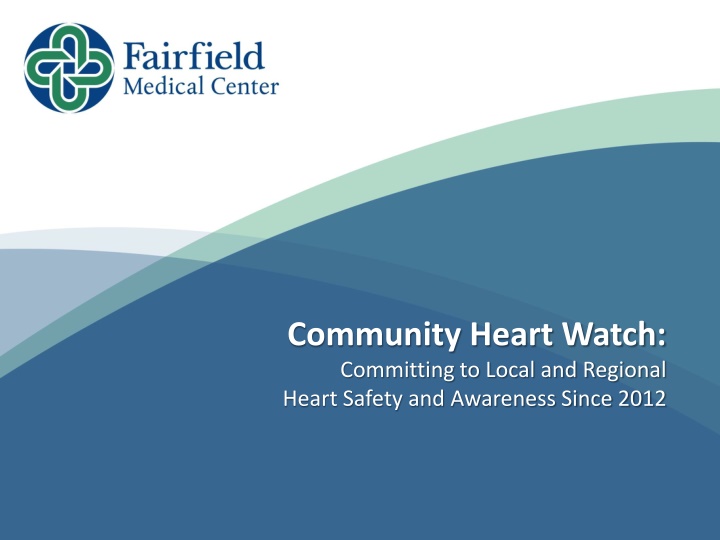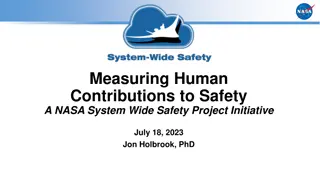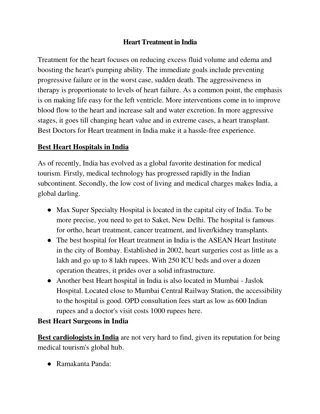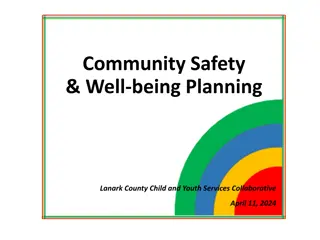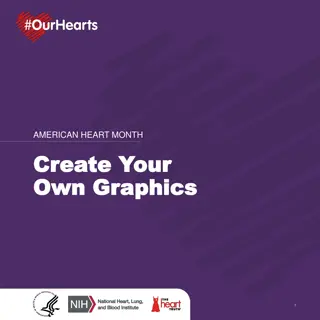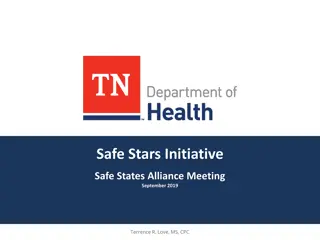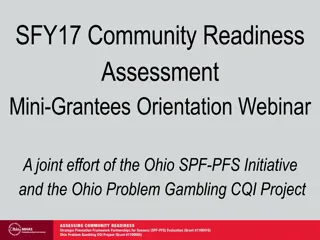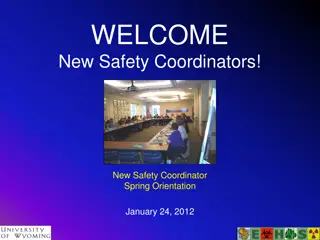Community Heart Safety and Awareness Initiative since 2012
Since 2012, Community Heart Watch has been dedicated to promoting local and regional heart safety and awareness. Sudden Cardiac Arrest (SCA) is a serious condition affecting people of all ages, with prompt CPR and defibrillation being crucial for survival. By emphasizing community engagement and response, lives can be saved. Learn how bystander intervention, AEDs, and overcoming fears play key roles in increasing SCA survival rates, particularly in regions facing unique challenges like Southeastern Ohio.
Download Presentation

Please find below an Image/Link to download the presentation.
The content on the website is provided AS IS for your information and personal use only. It may not be sold, licensed, or shared on other websites without obtaining consent from the author.If you encounter any issues during the download, it is possible that the publisher has removed the file from their server.
You are allowed to download the files provided on this website for personal or commercial use, subject to the condition that they are used lawfully. All files are the property of their respective owners.
The content on the website is provided AS IS for your information and personal use only. It may not be sold, licensed, or shared on other websites without obtaining consent from the author.
E N D
Presentation Transcript
Community Heart Watch: Committing to Local and Regional Heart Safety and Awareness Since 2012
Sudden Cardiac Arrest (SCA) Irregular heart rhythm or heart stoppage that results in a lack of blood flow to the brain and other organs the victim collapses and is at high risk of death Strikes people of all ages, including those without known heart disease even young and healthy athletes Impacts 350,000 Americans 1,000 per day Requires CPR to get the blood pumping and defibrillation (shock) to restart the heart Community engagement and response directly impacts SCA survival
Every Second Counts SCA results in death in minutes if care is not provided quickly Every minute defibrillation is delayed = 10% decrease in survival Nationally, 90% of victims do not survive 3 important interventions 1) Call 911 2) Bystander CPR 3) Defibrillation via AED
SCA: Bystanders and AEDs Save Lives Survival Rates 50% 30% 10% National Average With Bystander CPR With Bystander CPR & AED
Alleviating Bystander Fears Only 32% of SCA victims receive bystander CPR Less than 12% have an AED applied FEAR FACT I m not sure it is an emergency. If victim is not responding and not breathing it is an emergency. I m afraid CPR will hurt the victim it is better to wait for professionals. Bystander intervention while waiting for EMS saves lives you can t get deader, might get better. I might get a disease doing mouth- to-mouth. Hands-only CPR can be just as effective as conventional CPR. I m afraid the AED shock will hurt the victim. AEDs are safe they do not shock a victim if it is not necessary. I might get sued. Good Samaritan laws protect bystanders.
Unique Challenges in Southeastern Ohio Resource limitations, including: Equipment lack of available AEDs in rural areas Training relatively low rates of CPR-trained individuals Personnel EMS and volunteer fire departments responsible for large, less accessible geographic areas Rural and remote geography, potentially leading to: Delays in EMS arrival Disrupted communication Low population density, decreasing chance of bystander intervention
CARES Survival Rates when Resuscitation Attempted EMS: Athens, Bremen/Rushville, Lancaster, Millersport with Transport to FMC 2019 2020 36% 29% 19% 18% To Admit To Discharge Survival is closer to national average of 10% when including patients who die before EMS arrives
Snider Community Heart Watch Named after Dr. Gordon B. Snider, a cardiologist who brought the first intensive care unit to FMC Formed in 2012 following two SCA events: Misty Morrison age 27, SCA on Aug. 15, 2011 Claire Birkholz age 9, SCA on Sept. 16, 2011
Objectives Improve community (regional business, school and health care agencies) awareness of cardiac emergencies Identify unique solutions to regional challenges in effective response to cardiac emergencies including SCA Providing CPR training and certification to local schools, businesses, health care providers and citizens Improving access to AEDs lifesaving devices in SCA Celebrating heart saving efforts with Great Save Awards
Accomplishments Placed 300+ AEDs in the community Trained 10,000+ people in CPR and HOPE Accredited 50 schools as Heart Safe Accredited 11 business sites as Heart Safe Creating a regional AED map to better coordinate resuscitation for cardiac arrest
Current Membership FMC physicians, nurses and leaders Fire/EMS: Lancaster, Greenfield Township, Hocking County, Hocking Township, Millersport, Walnut Township/Thurston, Violet Township, Pleasant Township, Bremen/Rushcreek, Thornville, Basil/Baltimore Schools: Lancaster Public Business: Fairfield Federal Savings & Loan
Community Heart Watch: Initiatives 1) CPR training in the community 2) Heart Safe Business Accreditation 3) Heart Safe School Accreditation 4) Regional AED mapping and access Identify regions of AED shortages Place AEDs in areas of need Reduce time to defibrillation by coordinating emergency response and AED location
Heart Safe Business Accreditation 3 year accreditation criteria: AED(s) on site 50-75% of staff trained in CPR and AED use Quarterly emergency drills Annual SCA awareness event Accreditation is free (may be costs for AED and CPR training) Accredited businesses: Fairfield Federal 3 Fairfield National Bank 5 Center of Disabilities Stebelton Snider Law Fairfield County Utilities Fairfield County JFS
Heart Safe Business Accreditation Toolkit Contains all the forms and info needed
Heart Safe School Accreditation 3 year accreditation: same criteria as businesses Accredited 25 schools in our market and 25 outside market Accreditation assumed by Sudden Arrhythmia Death Syndromes (SADS) Foundation 2016 2019 Community Heart Watch assumed responsibility for HSSA for local market only in 2021
Regional AED mapping with PulsePoint When a cardiac emergency strikes, quickly finding an AED can save a life! That s where PulsePoint comes in a free app that shares AED locations with bystanders It also allows users to enter AEDs into the system just snap a picture and note the location Sends alerts to AED owners when batteries and pads are about to expire
PulsePoint on Your Phone Shows nearest AEDs on interactive map Provides a description of where the AED is located in the building Shows a photo of AED in context Shows the facility s hours of operation
What Can You Do? Be Informed, Be Aware & Be Ready Get trained in CPR Offer CPR training for your staff Get an AED for your business Hold an SCA awareness activity in your business Download the PulsePoint app, enter your AEDs and add PulsePoint materials to your website Accredit your business as Heart Safe Join Community Heart Watch (meet monthly for 1 hour)
